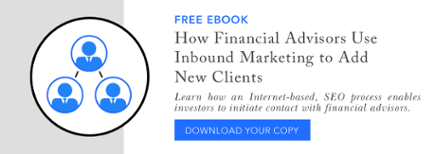5 Ways Financial Advisor Marketing Will Change in 2019
There’s no question, the Digital Age has changed everything. Not only has it changed the way consumers want information, but it’s also changed how companies need to market their services. The Internet puts more control into the hands of consumers, making them the ones to decide if and when they receive marketing, and by whom. This especially includes financial advisor marketing, an industry that has a bad rap for unwanted phone calls and “free” lunches that serve up an aggressive sales pitch.
This game-changing new way to think about marketing is called Inbound Marketing, a term used to describe the way that prospects come to a firm on their own accord, without being solicited.
Initially, this change of power may sound like bad news, but it’s not – not if you’re aware and prepared for the change. Financial advisors who understand the opportunities of this new norm and all the worthwhile benefits are actually benefitting from this non-aggressive, welcoming approach.
What Is Inbound Marketing?
Today, consumers are researching products and services through the Internet. They’re reading blog articles and checking reports through social media. Consumers get to sort through information and brands while they retain their anonymity. They don’t have to give up their personal contact information until they decide it’s time. It’s the consumers who choose when they want to be contacted and sign up, opt-in or download when they’re ready.
Inbound Marketing is powerful because these motivated investors are coming to you. They’re looking for information and asking for service and expertise, and if you can answer their questions, you have a good chance of landing a hot lead.
Harness the Power of the Internet
The Internet is a major game-changer, giving potential investors access to vast amounts of information and data. When financial advisors cater to the needs of this new breed of consumer, they can rely on the power of the Internet and Inbound Marketing to generate a steady source of viable leads to keep their firm healthy and flush for the long-term.
Successful advisors have been able to encourage this Inbound contact by offering worthwhile information and resources as they establish valuable relationships. Effective financial advisors do this by helping streamline the consumers’ search for information and directing interested prospects to the messages and topics they need. This helps everyone and makes the natural conversion from interested lead to a new client smooth and successful.
The first step in doing this is having an interactive, custom, lead-generating website. Step two is pairing a strong website with a smart Inbound Marketing campaign.
The Rise of Inbound Marketing
Inbound Marketing has become the most effective form of messaging used today. So where has it been all our lives and how did this highly personalized and successful form of marketing come to be?
All of us are consumers, and we know too well the old tactics employed through Outbound Marketing, such as cold calls and direct mail. No one is a fan of these outdated methods, but in the past, this was primarily the only way to connect with potential investors.
No Solicitation
In the 1950s and ’60s, new abilities in market research led to the mass collection of information related to customer habits. This led to a sharp rise in Outbound Marketing efforts in the form of door-to-door sales, commercials, print ads and cold calling. But many found that these methods were not the best use of financial advisor marketing dollars, nor did they set the stage for quality relationships and loyal clientele. In fact, the failure rates of these campaigns typically painted a bleak picture and left marketers searching for better methods. Many financial advisors left the field because of almost 100 percent rejection rates.
A decade or two later, market segmentation was at the core of a more purposeful strategy aimed at better understanding the customer in order to filter and present only the most appropriate messages. It was reasoned that by narrowing the information and limiting contact, all a business needed to do was make their product available so that it could practically sell itself as opposed to aggressive tactics and fancy salesmanship. This sounded favorable to many marketers who were tired of the high failure-rates of Outbound Marketing and the negative backlash generated by intrusive methods like cold calling.
A Better Way
As the Internet gained users and popularity, consumer habits changed drastically and businesses scrambled to adapt and survive. With the invention and widespread use of the Internet, there came many new developments for better marketing, including the opportunity to highly personalize messages. Eventually, it was acknowledged that disruptive forms of Outbound Marketing were no longer viable and that businesses had to start treating customers like people rather than lists if they wanted to have any impact in the crowded marketplace.
Today, customers no longer tolerate hard-sales tactics. Time-starved consumers may even be offended by bothersome marketing that is not relevant. Customers have more power than ever to scroll, block and otherwise abandon a site for better and more pertinent information elsewhere.
What this means for financial advisors is that creating personalized experiences for a unique consumer segment is no longer the ideal, it is the standard. With this realization came the success of Inbound Marketing, a strategy that makes sense on many levels as the desirable norm.
The possibilities with Inbound Marketing are endless, especially with the rise of increasingly targeted digital communication channels, automation tools and predictive analytics that allow advisors to learn more, faster, in order to personalize experiences for a defined audience.
How to Succeed
The more you know about how investors use the Internet, the easier it is to develop a strategy that ensures they can find you when they need you. This is crucial.
Once you know how investors are using the Internet, you can use that knowledge to develop a timely strategy that brings them to your website. When they do arrive, you then need to ensure your firm is offering the right content. Because if you do not meet their needs, pique curiosity or otherwise earn their attention, trust and respect, your lead will simply surf elsewhere.
Although the concept of Inbound Marketing is fairly simple, the act of getting up and running with a strategy can be overwhelming for a firm new to the Digital Marketing arena. Often, financial advisors lack the time and knowledge to know where to begin. The solution for many is to partner with a Digital Marketing expert. All the better if the expert you team up with has proven experience in the financial services industry.
Paladin Digital Marketing has the tools, experts and proven track record to get you quickly up-to-speed with a profitable Inbound Marketing strategy. You owe it to your business and your future success to find out how you can streamline and save with efficient Inbound Marketing.


